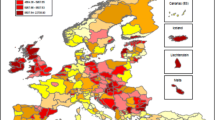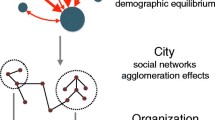Abstract
The chapter addresses the question of how open should a city region be? The approach is rooted in the literature on Spatial Interaction Models enlarged to integrate a productive space conceptualized as interconnected channels in which size can change instead of a space if inert links. The argument begins with the formulation of an open spatial interaction model with two channels: Cardo for the internal interaction and Decumanus for the external connection; both constrained by energy, environmental, technological, and economic restrictions. Results indicate that the optimal openness depends on relative structural centrality of the city region, or the length of Cardo and Decumanus, on the environmental capacity of the channels and on the multiplier effect of external connections.
Access this chapter
Tax calculation will be finalised at checkout
Purchases are for personal use only
Similar content being viewed by others
References
Alonso W (1971) The economics of urban size. In: Papers and Proceedings of the Regional Science Association, vol 26, pp 67–83
Camagni R, Capello R, Caragliu A (2013) One or infinite optimal city sizes? In search of an equilibrium size for cities. Ann Reg Sci 51:309–341. https://doi.org/10.1007/s00168-012-0548-7
Chadwick G (1978) A systems view of planning. Towards a theory of the urban and regional planning process, 2nd edn. Pergamon. ISBN: 9781483139388
Christaller W (1933) Central places in southern Germany (trans: Baskin CW). Prentice-Hall, Englewood Cliffs, NJ
Echenique MH, Grinevich V, Hargreaves AJ, Zachariadis V (2013) LUISA: a land-use interaction with social accounting model; presentation and enhanced calibration method. Environ Plann B Plann Des 40(6):1003–1026. https://doi.org/10.1068/b38202
Epifani P, Gancia G (2009) Openness, government size and terms of trade. Review of Economic Studies Limited, Oxford, pp 629–668. https://doi.org/10.1111/j.1467-937X.2009.00546.x
Fujita M, Krugman P (1995) When is the economy monocentric? von Thünen and Chamberlin unified. Reg Sci Urban Econ 25(4):505–528
Fujita M, Krugman P, Mori T (1999) On the evolution of hierarchical urban systems. Eur Econ Rev 43(2):209–251
Fujita M, Krugman P, Venables A (2001) The spatial economy. In: Cities, regions and international trade. The MIT Press, London
Henderson J (1974) The sizes and types of cities. Am Econ Rev 64:640–656
Kourtit K, Royuela V, Dentinho T, Nijkamp P (2015) Envisioning experiments on regional science frontiers. Investig Reg 36(36):35–61
Losch A (1954) The economics of location. Yale University Press, New Haven, CT. ISBN 978-0-300-00727-5. OCLC 876506870
Muntaha S (2005) Urban planning in a seaport city, Beirut from Hellenistic to Byzantine period. In: Morhange C, Saghieh-Beydoun M, Ala’eddine A (eds) La Mobilité des Paysages Portuaires Antiques du Liban. Bulletin d’Archéologie et d’Architecture Libanaises, Hors-série II, pp 147–184
Nijkamp P, Reggiani A (1988) Entropy, spatial interaction models and discrete choice analysis: static and dynamic analogies. Eur J Oper Res 36(2):186–196
Paelinck J, Nijkamp P (1976) Operational theory and method in regional economics. Saxon House, Lexington
Pred AR (1966) The spatial dynamics of U.S. urban industrial growth. MIT Press, Cambridge
Ricardo D (1817) Princípios de Economia Política e Tributação. Fundação Calouste Gulbenkian, Lisbon. 2015
Richardson H (1972) Optimality in city size, systems of cities and urban policy: a sceptic’s view. Urban Stud 9(1):29–47
Romer D (1993) Openness and inflation: theory and evidence. Q J Econ 108(4):869–903. https://doi.org/10.2307/2118453
Sen A, Smith TE (1995) Gravity models of spatial interaction behavior. Springer, Berlin
Shannon CE (1948) The mathematical theory of communication. Bell Syst Tech J 27:379–423. 623–656, July, October 1948
Smith A (1776) Riqueza das Nações. Fundação Calouste Gulbenkian, Lisbon. 1981 e 1983. 2 vols
Von Bertalanffy L (1969) General system theory: foundations, development, applications. George Braziller, Inc., New York, NY
Von Thünen JH (1826) Derisolierte Statt in Belziehung auf Landwirtschaft und National ökonomie. Part I. Pethers, Hamburg
Williamson O (1985) The economic institutions of capitalism. Free Press, New York, NY
Wilson AG (1970) Entropy in urban and regional modelling. Pion, London
Wilson A (2010) Entropy in urban and regional modelling: retrospect and prospect. In: Geographical analysis, vol 42. The Ohio State University, Columbus, OH, pp 364–394
Author information
Authors and Affiliations
Corresponding author
Editor information
Editors and Affiliations
Rights and permissions
Copyright information
© 2022 The Author(s), under exclusive license to Springer Nature Singapore Pte Ltd.
About this chapter
Cite this chapter
Dentinho, T.P. (2022). Optimal Openness. In: Kawano, M., Kourtit, K., Nijkamp, P., Higano, Y. (eds) Theory and History in Regional Perspective. New Frontiers in Regional Science: Asian Perspectives, vol 56. Springer, Singapore. https://doi.org/10.1007/978-981-16-6695-7_9
Download citation
DOI: https://doi.org/10.1007/978-981-16-6695-7_9
Published:
Publisher Name: Springer, Singapore
Print ISBN: 978-981-16-6694-0
Online ISBN: 978-981-16-6695-7
eBook Packages: Economics and FinanceEconomics and Finance (R0)




